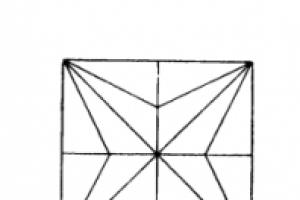There is often a need for extensive wooden panels. Such shields can be bought in a retail chain or made independently. To glue a high-quality shield yourself, you need to know some secrets of such work.
Procurement of starting material
1. For the shield it is necessary to select high-quality lumber. The boards must be the same width and moisture content, and have even grain along the entire length. Workpieces that already show signs of warping should be rejected.
2. The texture pattern should be similar and not differ much in color. When buying boards, it is advisable to choose them from one stack.
3. Wood moisture content should not exceed 8-9% for hard rocks, and for soft ones - no more than 12-14%.
4. The texture pattern of the lumber should be suitable for gluing into a panel. You should choose radial or intermediate cut boards. It is not advisable to use tangentially cut lumber, as they are more prone to warping.
5. Pay attention to the lines of the texture pattern. If such lines are not parallel, then this is a sign that the boards are prone to bending or twisting.
6. For gluing boards, you should choose boards up to 120 mm wide. Although this increases the number of glue seams, it reduces the likelihood of warping of the finished board. IN wide boards higher internal stresses, which subsequently leads to warping and cracking.
7. After larch lumber is brought to the workshop, they need to be given several days for the temperature and humidity to equalize.
Operating procedure
1. Plane the boards, leaving an allowance of 2-3 mm in thickness. If the shield is cut at a right angle, additional tolerances are required for the length of at least 50 mm, and for the width of the shield of at least 15 mm.
2. On a planer, one face of all boards for the shield is leveled.
3. All boards are calibrated to the required thickness using a thicknessing machine.
4. Then, again on the planer, one edge is aligned strictly at 90 degrees to the face of the board.
5. The second edge is cut on a compass and the saw marks are removed on a planer.
6. Prepare required amount clamps and flat surface, on which the shield will be glued.
Prepared boards must be immediately glued into the board. Since the delay can lead to warping of the prepared workpieces. If the width of the shield is large, then it needs to be glued in several parts in stages. The width of such parts should not exceed the width working area thicknesser so that after gluing they can be aligned in height. And the entire shield is glued together from the prepared and calibrated parts.
Before gluing the shield, it is necessary to prepare even bars of equal thickness, on which the prepared boards are placed. This will ensure the ability to easily fasten the clamps to the board being glued.
Having coated the edges with glue, install clamps and clamp them. The clamping force is controlled by the glue squeezed out of the joints. It should form a uniform roll. The installation of clamps begins from the edge of the shield. Having installed the first one and lightly clamping it, install it immediately at this edge quick clamps on all adhesive joints. This is necessary to ensure that the boards do not move relative to each other.
Then install the next clamp horizontally at a distance of 250-270 mm from the first and on the opposite side of the shield. At the same time, you need to ensure that the boards are in the same plane at all times. If necessary, they are leveled. Install the remaining clamps, alternating on the top and bottom sides of the shield.
Having reached the second edge of the shield, using quick-release clamps (which are removed from the first edge), fix the adhesive joints and install the last horizontal clamp.
After about five minutes, the vertical quick-release clamps are removed so that the glue in these places has a chance to dry.
As soon as the glue squeezed out of the joints dries slightly, it is removed using a scraper or spatula.
The clamps are removed after the glue has completely set.
On the site http://www.foresthouse.ru/- “Forest House” dedicated to woodworking products and the sale of inter-crown insulation can be additionally viewed various materials on the topic of wood processing and the construction of wooden log houses. This site contains a significant number of unique articles useful both for beginners and for masters working in the field of wooden country house construction.
This article belongs to an expert in the field of woodworking industry Zelentsov Yuri Nikolaevich. Copying the article without written consent is prohibited.
Beginning furniture makers sometimes face the problem of where to buy furniture panels. Factory samples are not always suitable for the intended design, but blanks can be made independently.
To make shields you will need special equipment: planer, grinding machines (belt and surface grinders). Choose boards for work of the same species, without knots, dried, with minimal warping. The best option– buy a log and cut it into pieces of the required size. The cutting angle is 90 degrees. Pine, oak, and birch are suitable for making shields.

















Wooden panels are very practical - they do not deform, have slight shrinkage, and the structure of the tree is not damaged, so investments in the production of lumber quickly pay off.
Successful busy people must have a hobby. This relieves stress and reduces the risk of a heart attack. You can collect candy wrappers and coins, or you can take up a serious craft. For example, glue a furniture panel with your own hands. The process is not as complicated as it might seem, but it requires at least minimal knowledge of the tool.
Tools and materials for making furniture panels
- Circular Saw.
- Milling machine.
- Drill.
- Hammer.
- Electric planer.
- Belt and surface grinders. You can strip wood emery cloth, screwing it onto the block. True, it will take a little longer.
- Reismus.
- Clamps or homemade devices for tightening boards.
- Long metal ruler, pencil, tape measure.
- Lumber.
- Plywood and thin slats for holding the shield together.
- Glue.
Preparatory work
First, let's decide what size furniture panel we need in order to stock up on enough material. In any case, the blanks should be longer and thicker than the final parameters of the shield. We select boards from wood of the same species, dry and smooth, with a minimum of knots. It is also necessary to know the basic properties of wood. We offer a small carpenter’s dictionary so as not to get confused in the concepts:
- Faces are the wide longitudinal sides of the boards.
- Plots are separate bars, planks, cut from a wide board.
- The lamellas are solid, unjointed pieces. Actually the same as plots.
- Looseness is a random arrangement of wood fibers in a workpiece. It occurs when a board is cut from the butt of a tree.
- Sapwood is the outer layer of wood located just below the bark.
According to the advice of old masters, how to make a furniture panel good quality, plots are taken that have a width to thickness ratio of 3x1. This lamella is stable because the internal tension of the wood is not enough to split the lath. We've all seen boards that are cracked at the ends. This is the case when the stress of the material caused by improper drying splits the workpiece. This means that we first cut the lumber into slats no more than 15 cm wide. During the cutting process, we also remove all defective sections of the boards.
Before assembling the panel, we take into account that wood warps when dried. different directions. It is strongest in the direction of the growth rings (tangential direction), and twice as weak in the direction of the core lines (radial direction). We glue the sawn blanks in the order indicated in the very first photo:
Panels a and b: core to core, sapwood to sapwood. This will avoid warping when the shield shrinks, which reduces the strength adhesive joints.
Shields c and d: we orient blanks with pronounced curling along the lines of annual rings, then the deformation of the finished shield will be much less.
Step-by-step instructions for making furniture panels

Methods for connecting plots in a shield
How to make a furniture panel with your own hands so that the wood retains its original stability in the future? There are several ways to cope with the warping of the board caused by the curling of the lumber.
We glue the lamellas on the dowels (the bottom panel in photo 6) or use the finishing tips, following the example of the drawing board. To fix short boards, we use a tip with a tongue-and-groove assembly (top panel in the photo), connected flush to the lamellas. The tip may have a protrusion above one (middle shield) or both faces, depending on the purpose of the product.

If the furniture board is intended to be used in conditions of constant fluctuations in humidity, it would be more advisable not to glue the boards together. Compensation for wood due to frequent swelling is achieved by various methods of consolidating plots. The top panel in photo 7 is connected in a quarter, the middle one in a quarter with chamfering from the upper edges. The boards of the lower shield are also joined together in quarters, but with a selection of profile edges on front side.

Another type of joining plots without using glue is the use of floor strips. The top panel in photo 8 is secured with a regular strip, the middle one with a profiled strip without grooves, and the bottom one with a profiled strip with grooves.

If the furniture board will be used under constant mechanical load, in conditions of high humidity and temperature changes, then the boards must have a more powerful interface. Photo 9 shows examples of such connections. The top panel is assembled on dowels, the middle panel is assembled on a plywood strip. The width of the slats should be equal to the thickness of the plots, the thickness of the slats should be one third of the thickness of the plots.

The example of the lower panel shows a tongue-and-groove connection used for laying floors or cladding partitions. All these methods can be used in the manufacture of collapsible panels (for example, for sliding furniture). Glue is not used in these connections.
Gluing lamellas on dowels requires perfect precision in the location of the holes, otherwise the geometry of the shield will be disrupted. Nests are marked with markers. It is best to drill the ends using a drill stand and stop. The total depth of both holes should exceed the length of the fastening element by 2-3 mm.

If not milling machine, grooves and profiles at the ends are removed using a drill mounted on a stand. The appropriate cutter is installed on the tool and the speed is turned on at high speed.

The assembled, dried and sanded shield is filed to the required size. Now you can put it to work - making furniture, doors, window sills, sheathing walls and ceilings. Durability, aesthetics, naturalness furniture panels- This best recommendations for building material.
Furniture panel is a specific type wood materials, created by gluing standard planed wooden blocks. It is effectively used to create various types of fittings and coatings. Making a furniture panel with your own hands at home is not at all difficult, so this work is accessible to self-execution every person. The resulting structures are natural and environmentally friendly, and at the same time much more attractive than chipboard or MDF.
Creating a furniture panel with your own hands at home involves the use of different types of wood. Most often, birch or oak, beech or aspen are used for this, as well as larch and various conifers.
Each type of wood has its own characteristics, so before making a specific choice, it is recommended to determine in advance the operating conditions under which the resulting contract will be used.
Furniture panels are most often used to create different furniture and doors. They are distinguished by the presence of specific internal stress, so during the work you need to be careful so as not to damage the integrity of the structure. Improper work can lead to deformation of the finished product.
The main advantages of furniture panels are:
- environmental friendliness due to the use of natural ingredients and high-quality glue;
- exquisite appearance the resulting furniture and other structures, but this is only possible with proper processing of the boards;
- high practicality, since wood has a homogeneous structure, which allows you to restore broken or unattractive elements;
- making furniture panels is an incredibly simple task, and a small amount of money is spent on this process;
- furniture made from panels is durable and attractive;
- the products do not have any cracks or other deformations, and are not subject to significant shrinkage.
The main factor in obtaining a high-quality shield is the competent choice of material for these purposes. Typically, furniture panels are 2 cm thick, so blanks are initially prepared optimal size, as well as having the required thickness. Since the boards will certainly have to be planed and then sanded, they should be purchased with a reserve, so their thickness should be 2.5 cm.
When choosing a material, you should focus on the type of wood, as well as the quality of the boards. The wood must not be uneven or warped. It must be of high quality, properly dried and completely free of any rotten areas. Therefore, you should carefully inspect the boards before purchasing. Additionally, the accompanying documentation for the material is studied in detail.





Required Tools
Do-it-yourself furniture panel gluing is done using standard tools. Usually they are available to every man who prefers to do numerous housework on his own. Therefore, only the elements are prepared:
- planing machine that ensures optimal preparation of wood;
- a tool for joining and gluing individual wooden blocks;
- belt type sander;
- construction level, allowing you to get really even panels;
- coarse sandpaper;
- flat sander.
These tools will be enough to make a shield, so no expensive devices will be needed anymore.

Manufacturing rules
As soon as the tools are completely ready for the planned work, the actual production procedure begins. How to make a furniture panel? This process is not considered too complicated, but in order to eliminate possible mistakes or problems, it is recommended to study the correct instructions in advance. To do this, follow the following steps:
- originally wooden boards are cut into separate bars that have the right size, and it is important to make cuts in such a way that they are strictly at right angles;
- The presence of any unevenness or other defects is not allowed, since in this case it will not be possible to properly glue the furniture board together;
- if minor distortions are detected, they can be eliminated with a conventional planer;
- An important point in production is the combination of the resulting blanks, since they must be the same in texture and color, as well as in other important parameters;
- After selecting the elements, they are marked so that during the gluing process there are no difficulties with their correct location.
To ensure that all stages of the process are completed taking into account the main nuances, it is recommended to watch the training video in advance.

Making bars

We process with a machine

We mark each block
Element gluing technology
After all the bars have been prepared, you can begin gluing them directly, which will ensure a high-quality shield. This procedure is also divided into successive stages:
- a device is selected that makes it possible to glue the bars together, and it must be even, and usually a regular sheet of chipboard is used for this;
- strips are fixed along the edges of the sheet, and their height depends on the parameters of the prepared bars;
- bars are laid between these slats, and they should fit tightly to each other and an attractive pattern should be formed from them;
- if there are cracks, they can be easily eliminated with a standard jointer;
- then the bars are glued together, for which they are used different types glue intended for wood, but the use of PVA glue is considered optimal;
- the entire surface consisting of bars is completely spread with glue, and it is important that the product is evenly distributed over the surface;
- the lubricated elements are pressed tightly against each other;
- on slats, fixed to chipboard sheet, two more such planks are laid, after which these elements are connected with self-tapping screws, and this is necessary to prevent the resulting shield from bending;
- the resulting blank is left for about an hour, after which the shield is released and left for a day.
Thus, having figured out how to glue elements to obtain a furniture panel, this process will not require significant effort. The procedure is easy to implement on our own, and the result is structures that are effectively used to create numerous furniture, doors or even full-fledged coatings, characterized not only by high strength, but also reliability, as well as an attractive appearance.

Fastening the slats

Lay out the bars


We lay two more planks

Leave to dry
Final processing
Shields are made in such a way that they are not only strong and durable, but also quite attractive. To this end, attention is paid to some finishing stages, consisting in special treatment. To do this, follow these steps:
- a preliminary grinding procedure is carried out. For these purposes, it is recommended to use a standard tape grinder. You need to insert a special sandpaper, and it must have large fractions, since the initial processing is being done. It allows you to eliminate large defects and differences remaining on the surface after the process of creating the shield. You must act carefully, and also carry out the process in consistent and even lines;
- secondary processing - involves the use of flat grinding machine. It ensures the removal of the slightest differences, irregularities and other defects present on the surface of the wooden furniture panel. Also, due to this process, lint is removed from the surface. It is recommended to pre-moisten the base with a small amount of water, and start sanding only after the structure has completely dried.
After competently implemented processing, it is possible to use the resulting panels to create a variety of tables or shelves, bedside tables and other furniture. They can be used to form doors or coatings that have high strength, reliability and durability.
The figure shows another way to connect wooden parts: gluing boards into a shield (panel for carving) and additionally fastening wooden transverse strips in the shape of a tenon. Rafted boards or bars in shields must be directed along the long side of the shield, in square or round shapes - vertically. Material components taken from the same wood, mainly from the same trunk; the material of the transverse planks should, as a rule, be made from another wood, more durable or having other advantages: for example, it is known that oak is not afraid of moisture, pine and spruce are also less susceptible to hygroscopicity, less worn down by wood-boring beetles, cedar, olive, larch, Boxwood is resistant to rotting and cracking. Cross bars(dowels) have a trapezoidal profile (“ dovetail") and slightly taper towards the end in the shape of a wedge. They are driven into sawn grooves one towards the other.
Manufacturing technology of composite shields
Dried wood is carefully checked to detect and eliminate defects that are likely to interfere with work.
First take planed boards required length and thickness, taking into account an allowance from 30 to 100 mm, and the face and edge are jointed at an angle of 90°. The width of the boards when gluing can be from 50 to 100 mm. The quality of the joint is checked against the light, applying the edges to each other. The precision of edge jointing must be high enough, otherwise the shield may crack at the gluing site both during and after the carving process.
When laying out the blanks into a shield on the front side where the carving will be done, select the texture pattern and color of the wood, since the “striping” of various blanks can affect the quality of the product and reduce the overall effect.


Gluing wooden blanks with edges to obtain large-width panels:
clamping with screws and wedges
The jointed workpieces are placed in clamps or clamps (in the pictures above), the correct layout at the ends, the texture pattern and the density of the edges are checked, the edges are smeared with glue and clamped with screws or wedges. To obtain workpieces with a large cross-section, the boards are glued together in layers

Gluing boards in layers into blocks to obtain a workpiece with a large cross-section:
1 - workpiece, 2 - clamping screw.
To glue the shields, depending on where the decorations will be located, use different kinds glue. So, for gluing shields that will be installed on outdoors, casein and synthetic adhesives are used, which have great bonding strength and high water resistance.
For carved panels, souvenirs and other products use synthetic as well as glutinous (carpentry) glues. There are casein adhesives, carpentry adhesives, PVA emulsion, EDP glue, etc. on sale. The method of application is usually indicated on the labels or in the instructions. Types of adhesive joints are shown in the figure.

Types of side adhesive joints in panels:
1 - connection to a smooth reveal; 2 - connection on dowels; 3 - rail connection;
4 - quarter connection; 5 - rectangular spike; 6 - triangular spike;
7 - oval spike; 8 - trapezoidal tenon; 9 - dovetail spike.
Properly glued panels are less susceptible to warping. Sometimes panel boards or other large carvings may come into contact with a surface that is subject to cooling or moisture, which in turn can cause warping. In this case, the shields are reinforced by gluing profiled bars or slats into the end or face.

Reinforcement of panels with inserts of profiled beams and slats:
1 - gluing of timber with a rectangular tenon; 2 - gluing in a rectangular strip; 3 - gluing in trapezoidal beams.
Lumber that is sold in “Building Materials” stores is also suitable for house carving: linings, boards and bars for flooring. They are easy to glue because they are already milled and have a specific cross-sectional shape.
After drying, the glued boards are carefully smoothed out and cleaned with a plane with a double piece of iron or a jointer. The boards are not sanded before carving, since when grinding, crumbs of abrasive powder get stuck in the pores of the wood and greatly dull the tool.
The ideal case for the durability of the parts being connected is the use of stained wood, that is, wood that has been in water for a long time. For miniature crafts, the desired material is pear, which retains its shape well when dried, with wild pear being more durable.
It remains to recommend, if the opportunity arises, to use the middle lobe cuts of the same trunk to compose the shield; they prevent warping when drying. It must be remembered that when drying, the board bends in the direction of straightening the annual layers.








